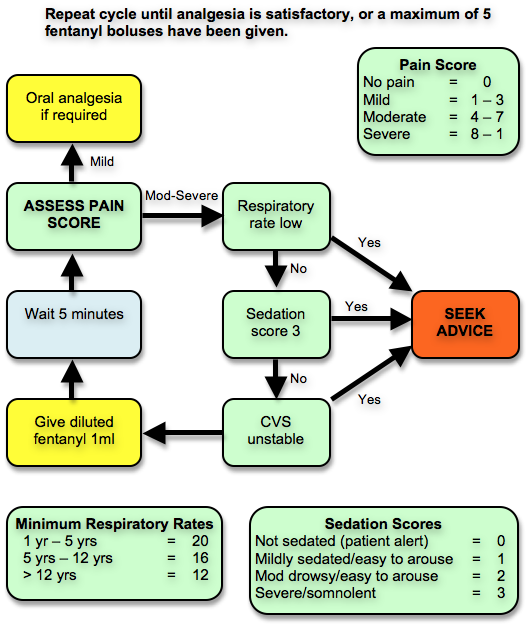Emergencies (see individual guidelines)
- WETFAG
-
Weight (>5 years old)(3 x age) + 7Energy4 J/kgETT Size(age/4) + 4ETT Length(age/2)+12Fluid bolus (crystalloid)10-20 ml/kgAdrenaline10 mcg/kg= 0.1 ml/kg 1:10,000Atropine20 mcg/kgDextrose 10%2 ml/kg
- Anaphylaxis
-
Intravenous: for a periarrest situation draw up arrest dose of adrenaline (0.1 ml/kg () 1:10,000) and dilute to 10ml with saline (1 mcg/kg/ml ()).
Use 0.5 - 1 ml () IV boluses to treat hypotension (with fluids as appropriate).IM Adrenaline 1:1000<6 years150 mcg (0.15 ml)6-12 years300 mcg (0.3 ml)>12 years500 mcg (0.5 ml)Chlorphenamine<6 months250 mcg/kg<6 years2.5 mg6-12 years5 mg>12 years10 mgHydrocortisone<6 months25 mg<6 years50 mcg (0.15 ml)6-12 years100 mcg (0.3 ml)>12 years200 mcg (0.5 ml)
- Local Anaesthetic Toxicity
-
Intralipid Bolus1.5 ml/kg over 1 minIntralipid Infusion15 ml/kg/h
- Malignant Hypothermia
-
Dantrolene2.5 mg/kg
Anaesthetic Drugs
- Induction Agents
-
Propofol3-5 mg/kgThiopentone3-5 mg/kgKetamine1-2 mg/kg
- Muscle Relaxants
-
Suxamethonium1-2 mg/kgRocuronium0.6 mg/kgRocuronium RSI0.9 mg/kgAtracurium0.5 mg/kgMivacurium0.2 mg/kg
- Opiates
-
Fentanyl1-3 mg/kgMorphine0.1 mg/kg
- Reversal Agents
-
Neostigmine/Glyc0.02 ml/kgSugammadex16 mg/kg
- Antimuscurinics
-
Atropine20 mcg/kgGlycopyrrolate10 mcg/kg
- Local Anaesthetics
-
Lignocaine3 mg/kg1%2%Lignocaine+adrenaline7 mg/kg1%2%Levobupivacaine2 mg/kg10 mg/ml (1%)20 mg/kg (2%)
Analgesia
- QParacetamol
-
OralLoading20-30 mg/kgThen15-20 mg/kg 4-6 hrlyMax75 mg/kg/dayRectalLoading30-40 mg/kgThen15-20 mg/kg 4-6 hourlyMax75 mg/kg/dayIntravenousDose15 mg/kg 4-6 hrlyThen60 mg/kg/day
- QDiclofenac
-
Oral
Dose1 mg/kg 8 hrlyMax3 mg/kg/dayRectalDose1 mg/kg 8hrlyor2 mg/kg 16 hrlyMax3 mg/kg/day
- QIbuprofen
-
Oral
Dose5-7.5 mg/kg 6 hrlyMax30 mg/kg/day
- Tramadol
-
Oral
Dose50-100 mg 4-6 hrly50-100 mg 4-6 hrlyMax400 mg/day400 mg/day
- Fentanyl
-
Intravenous boluses
Flowchart

- Morphine
-
Oral
Dose200-400 mcg/kg 4-6 hrlyIntravenousDose50 mcg/kg bolus over 2 minsMax200 mcg/kg 2 hrly
- A registered nurse must remain with child for 20 minutes after bolus.
- Respiratory rate must be noted every 5 minutes for 20 minutes.
- Full observations every 15 minutes.
- Write up prn Naloxone 4 mcg/kg ( ).
InfusionMix0.5 mg/kg made up to 50ml in 0.9% Saline (10 mcg/kg/ml)Rate1-4 ml/hr (10-40 mcg/kg/hr)- A dedicated giving set with antireflux and antisiphon valves must be used.
- Adequate IV loading doses of Morphine must be given prior to infusion.
- Refer to pain guidelines (Appendix E) about observations and actions.
- If rate is increased, observations revert to 15 minutes for 1 hour.
- All children < 1 year must have continuous apnoea monitoring and SpO2.
- Write up prn Naloxone 4 mcg/kg ( ).
- QDiamorphine
-
Intranasal
Dose is 100 mcg/kg () bolus over 2 minutes. Volume is always 0.2 ml.
- Explain procedure to child and family.
- Mix diamorphine 5mg in ml NaCl ( mg/ml)
- Draw up solution with 1 ml syringe and then discard solution until only 0.2 ml () is left in syringe.
- Gently tilt child backwards and put a couple of drops at a time into each nostril. 0.2 ml is approximately 8-10 drops.
- Ask the child to sniff hard. The child will probably sneeze.
- Naloxone
-
Intravenous
Dose4 mcg/kgRepeat every 2 minutes if no response observed.For respiratory depression:< 3 years: rate < 15/minute.> 3 years: rate < 10/minute.
Antiemetics
- QCyclizine
-
Oral/IntravenousDose<12y - 1 mg/kg 8hrlyMax50mg
- QOndansetron
-
Oral/IntravenousDose<12y - 100-150 mcg/kg 8hrlyMax4 mg 8hrly
- QDexamethasone
-
IntravenousDose<12y - 100-150 mcg/kgMax8 mg8 mg
Antibiotics
- Flucloxacillin
-
Orthopaedic ProphylaxisIV25 mg/kg (max 1g)
- Doses are from Greater Glasgow and Clyde paediatric guidelines.
- If surgery prolonged repeat after 4 hours.
- Teicoplanin
-
Orthopaedic ProphylaxisIV10 mg/kg (max 400mg)
- Doses are from Greater Glasgow and Clyde paediatric guidelines.
- Current general Orthopaedic guidelines suggests 400mg in adults independent of weight.
- Current spinal guideline use 6 mg/kg () in adults, with a maximum of 600mg.
- Slow to achieve adequate tissue levels, so requires very early administration, especially if tourniquet is used
- Long half-life
- If surgery prolonged do not repeat dose.
- Gentamicin
-
Orthopaedic prophylaxisIV2 mg/kgUrology & Spinal ProphylaxisIV3 mg/kgTreatmentIV5 mg/kg
- Doses are based on Ideal Body Weight (IBW) so which will need calculating and dose subsequently reduced.
- Reduce dose in renal impairment.
- Coamoxiclav
-
Prophylaxic doseIV30 mg/kg (max 1.2g)
- Doses are from Greater Glasgow and Clyde paediatric guidelines.
- If surgery prolonged repeat after 4 hours.
- Cefuroxime
-
Prophylaxic doseIV50 mg/kg (max 1.5g)
- Doses are from Greater Glasgow and Clyde paediatric guidelines.
- If surgery prolonged repeat after 4 hours.
- Amoxycillin
-
TreatmentIV50 mg/kg
- Clindamycin
-
Orthopaedic ProphylaxisIV5 mg/kg (max 300mg)
- Infused over 15 minutes.
- Doses are from Greater Glasgow and Clyde paediatric guidelines.
- If surgery prolonged repeat after 4 hours.
- Metronidazole
-
TreatmentIV7.5 mg/kg
Other
- Midazolam Premedication
-
Oral500 mcg/kg (max 20mg)
- 15-30 minutes pre-procedure.
- Diazepam
-
Oral0.2-0.3 mg/kg 8hrlyIV0.1-0.2 mg/kg
- Treats muscle spasm.
- Beware sedation and CVS depression.
- Baclofen
-
Oral1-10y - 0.75-2 mg/kg dailyOral10-18y - 5mg tds increased gradually to max 2.5 mg/kg
- Treats muscle spasm and chronic spasticity.
About
- Paediatric Dose Calculator
-
Paediatric Dose Calculator is an amalgamation of the Paediatric Pain Guideline (written by Mike Walburn and Rachel Brown) and the Paediatric checklist.
Sliding the age will change the weight using the WETFAG formula depending on age. If less than 1 year, a month slider will appear.
Although I have tried checked this, it is possible there are some bugs, so do not take everything as gospel.
Let me know if you find any problems.
© Ian Sidwell May 2017. Updated April 2019.